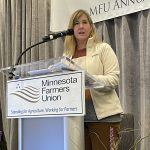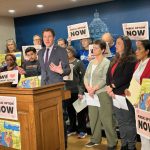Legislative Update: Legislative session begins
The 2024 legislative session officially kicked off on Monday, Feb. 12 for the second year of what has already proved to be a consequential biennium for policy in Minnesota. MFU’s leadership and government relations team hit the ground running, meeting with key lawmakers and planning for our annual Lobby Day Drive-in on Tuesday, Feb. 20.
It’s not too late to sign up to join us for Lobby Day—let us know you’re coming here: bit.ly/lobby2024rsvp.

Lobby Day is how we set the tone for session, build relationships, and help lawmakers understand our priorities as an organization. This year, early grassroots action will be particularly important. While MFU enjoyed success in 2023—taking the first step on a public option, establishing a grain indemnity fund, funding cooperative development, funding for broadband, checks on prescription drug prices and more—there is reason to believe that this legislative session will present new challenges. In short, that is because lawmakers could be feeling short on time, money and attention:
Time – first, this is a short session, totaling only 14 weeks (including holidays), with just six weeks to hear new bills. According to our constitution, Minnesota budgets on a biannual basis and this is the second year of the biennium. This second, shorter session is typically reserved for resolving policy issues, making tweaks to the budget and approving borrowing for infrastructure projects. First and second committee deadline will be on Friday, March 22 by which time committees in both the House and Senate need to approve most bills. If new proposals don’t get a hearing by then, they’re likely dead until 2025.
Money – second, lawmakers will have significantly less money. Late last year, state budget officials revealed updated estimates showing an improved financial picture for the state, forecasting a stable outlook for the current biennium with a newly increased surplus of $2.4 billion. That said, forecasted revenues this biennium are $60 billion while spending is upwards of $70 billion, creating a structural deficit. So how is this a balanced budget? That’s because the legislature allocated the bulk of last year’s significant budget surplus toward spending in this biennium.
The budget is ‘constrained’ according to forecasters looking into the next biennium, 2026 and 2027. In these years, revenues are $64 billion and projected spending is $66 billion, again leaving a structural deficit. However, according to this forecast we still won’t be left with a deficit because again there will be enough surplus left over to cover the imbalance.
To sum up, there is no projected deficit in this forecast because of the massive surplus we had to start. However, we are structurally spending more than we are bringing in, so once the carryover money the state has collected is gone, we may be faced with a shortfall. Two things that are important to note are that these estimates now include inflation and account for nearly $3 billion left in the states reserves to address emergencies.
The upshot is that whether it be an expanded loan forgiveness program for large animal veterinarians or a public option for healthcare, securing funding for new initiatives will be more challenging in 2024.
Attention – third, the House is in cycle. It will be a surprise to no one that when lawmakers are up for election it makes it harder to pass legislation. Not only is their attention divided, but the impulse to draw a distinction between them and their opponent makes it even more difficult to take a compromise position on a tough issue.
Finally, and importantly, we know some about what to expect from policymakers because they’ve told us.
“It feels to me like this is going to be — if you will, and we’ll knock on wood — a more normal off-budget year,” said Gov. Tim Walz on MPR. “Focusing on bonding, clean up a few things that need to be cleaned up.”
“Because of the quantity of changes that were made to state law last year, I would anticipate a much less active session this year,” said House Speaker Melissa Hortman, DFL-Brooklyn Park.

Speaker of the House Melissa Hortman at the Minnesota Farmers Union State Convention.
Both have been clear that a priority is passing a bonding package. You can find a full list of the projects included in Walz’s $982 million request.
Since this is the second year of the biennium, leadership, chairs and committee members will stay the same. One notable exception is now Senate Majority Leader Erin Murphy, DFL-St. Paul, who will be taking over for Sen. Kari Dziedzic, DFL-Minneapolis, who stepped down due to challenges related to her battle with cancer.
“I am honored by the vote of my Senate colleagues, and I’m committed to working with all the members of the diverse DFL Caucus to serve the people of Minnesota wherever they live,” Murphy said upon assuming her role. “In the coming months, following the example set by Leader Dziedzic, we will continue our work building on what we accomplished in the 2023 legislative session to meet Minnesotans where they are at, and to improve their lives.”
Majority Leader Murphy has been a strong ally to MFU, including during her time serving on the Senate Agriculture Committee. As State Government Chair last session, she championed successful efforts to secure additional funding for the Attorney General’s office to tackle competition issues.
While there are significant challenges this session, there are also important opportunities to make continued progress.
MinnesotaCare Public Option
Issues on the docket this year include the MinnesotaCare Public Option, which MFU has worked hard to advance since 2016.

A press conference on the public option was held Feb. 14, 2024, at the state Capitol.
 The proposal, which continues to be championed by Senate Health and Human Services Chair Melissa Wiklund, DFL-Bloomington, and Majority Leader Jamie Long, DFL-Minneapolis, would allow farmers and other small business owners to ‘buy-in’ to the quality coverage provided to lower income Minnesotans. Last year, the legislature authorized a Public Option and directed the Minnesota Department of Commerce to conduct the actuarial analysis needed for submitting the necessary federal waiver.
The proposal, which continues to be championed by Senate Health and Human Services Chair Melissa Wiklund, DFL-Bloomington, and Majority Leader Jamie Long, DFL-Minneapolis, would allow farmers and other small business owners to ‘buy-in’ to the quality coverage provided to lower income Minnesotans. Last year, the legislature authorized a Public Option and directed the Minnesota Department of Commerce to conduct the actuarial analysis needed for submitting the necessary federal waiver.

Rep. Jamie Long
Early this month, Commerce completed that report. It outlines two plans, one of which expands the existing MinnesotaCare program. Building off MinnesotaCare, this plan would cover trips to the emergency room, doctor and clinic visits, hearing aids, dental, eyeglasses, and a long list of other services all with limited cost sharing. Mental health or substance abuse visits, for example, don’t come with any copay, emergency room visits carry a $100 copay, and prescription drug costs to the patient are capped at $70 per month.
Together with a coalition representing workers, healthcare employees, national experts and others, MFU issued a joint statement:
“For years, Minnesotans have spoken out about high healthcare costs . . . we can and must do more to ensure Minnesotans have access to strong healthcare coverage, building on a successful public health insurance program,” said MFU President Gary Wertish. “This report provides the tools lawmakers need to move forward this legislative session. It is now incumbent upon the Minnesota Legislature to act to advance MinnesotaCare as a Public Option.”

Gary Wertish
A main challenge beyond the remaining complexity with crafting this first-in-the nation program, is that the plan carries a significant price tag—anywhere from $113 to upwards of $350 million annually. For a jurisdiction like agriculture, that is a big number. But healthcare is expensive. This year, current programs at the Department of Human Services will cost nearly $58 billion (including federal passthrough).
The House Agriculture Committee Chaired by Rep. Samantha Vang, DFL-Brooklyn Center, will hold their first meeting on Thursday, Feb. 15 at 1 p.m. to hear overviews from the Minnesota Department of Agriculture, the Agricultural Utilization Research Institute (AURI), and staff at the Agricultural Research, Education, Extension, and Technology Transfer (AGREETT) program. As always, you can find an updated schedule of committee hearings—and tune into livestreams on the legislature’s website.
Ag census released
On the federal level, USDA released the Census of Agriculture yesterday, updating data from 2017. Some highlights include 181,000 new acres of cover crops and big increases in the numbers of emerging farmers (shout out to the work of MDA’s Emerging Farmers Office). There are also some hard numbers to see. Minnesota has lost well over 3,000 farms since 2017 (68,822 to 65,531) and the number of dairies decreased from 3,644 to 2,185. The average farm size in the census increased from 371 to 388 acres.
This information will help guide policymakers as they work to craft the upcoming Farm Bill.
As always, if you have questions, thought, or concerns about MFU’s legislative work, please reach out to Stu at stu@mfu.org or (320) 232-3047.
